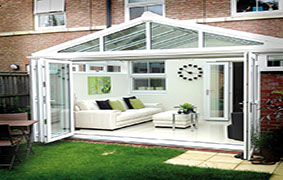
Conservatory Planning and Design Tips 2025: Your Expert Guide
Master conservatory planning and design in 2025 with expert tips on style, materials, layout, and efficiency for a perfect extension.
Conservatory Planning and Design Tips 2025: Your Expert Guide
Planning a conservatory is an exciting chance to expand your home, but it’s more than picking a style and breaking ground. In 2025, smart design and careful planning can turn a basic extension into a functional, beautiful space—whether it’s a £5,000 lean-to or a £30,000 P-shaped masterpiece. This guide offers expert tips on layout, materials, orientation, and more, ensuring your conservatory enhances your lifestyle and property value.
Start with Purpose and Space
Define how you’ll use your conservatory—lounge, dining, office, or greenhouse? This shapes size and style. A 10m² lean-to suits a cozy nook, while a 20m² P-shaped design fits multi-use needs. Measure your garden—permitted development (PD) limits extensions to 3m (semi-detached) or 4m (detached) and 50% of outdoor space. Sketch your layout early to avoid cramming or wasted potential.
Choose the Right Style
Match the conservatory to your home’s architecture. Victorian (curved, ornate) suits period properties, Edwardian (square, simple) blends with modern or classic, lean-to (sloped, minimal) fits bungalows, and P-shaped (sprawling, hybrid) works for larger homes. In 2025, hybrid styles with tiled roofs are trending for year-round use—consider your aesthetic and practicality balance.
Orientation and Light
Position matters. South-facing conservatories get max sunlight—great for plants but hot in summer (add blinds, £300-£1,000). North-facing ones stay cooler, ideal for offices but dimmer. East suits morning light, west afternoon glow. Use solar-control glazing (£500-£2,000) or ventilation (roof vents, £200-£500) to manage heat. Test your spot with a day’s observation before committing.
Material Choices
Frames set the tone: uPVC (cheap, durable, £500-£1,000/m²), aluminum (sleek, strong, £600-£1,200/m²), or timber (warm, premium, £800-£1,500/m²). Roofs range from polycarbonate (light, £1,500-£3,000), glass (bright, £3,000-£7,000), to tiled (insulated, £6,000-£12,000). Opt for double/triple glazing (U-value 1.6-0.8 W/m²K) over single—efficiency pays off long-term.
Key Planning and Design Tips
Here’s a quick reference for critical decisions:
| Aspect | Tip | Cost Consideration |
|---|---|---|
| Size | Stay within PD limits or budget for permission (£258) | £500-£1,500 extra if over PD |
| Roof | Tiled for insulation, glass for light | £1,500-£12,000 |
| Glazing | Double/triple glazing for efficiency | £500-£3,000 |
| Ventilation | Add roof vents or opening windows | £200-£1,000 |
| Heating | Underfloor or radiators for winter | £1,000-£3,000 |
Heating and Cooling
Plan climate control upfront. Underfloor heating (£1,500-£3,000) warms winters, while radiators (£500-£1,500) are cheaper. For summer, ceiling fans (£100-£300) or portable AC (£300-£800) beat heat. Insulation (tiled roofs, £6,000-£12,000) cuts both extremes—pair it with shading (blinds or film) for best results.
Planning Permissions and Regs
Stick to PD rules (under 4m high, 3-4m depth) to skip planning permission (£258)—check with your council. Tiled roofs or structural changes need building regs (£200-£800) for safety and U-value compliance (1.6 W/m²K max for glazing). In conservation areas, match materials to your home—permission may apply. Start early; approvals take 8-13 weeks.
Interior Design Tips
Maximize light with pale colors or mirrors—dark tones shrink the feel. Furniture should fit the shape: long tables for lean-to, round for Victorian bays. Add storage (shelves, £100-£500) to declutter. Plants thrive here—use them to tie indoors and out. Keep access fluid—French or sliding doors (£500-£1,500) ease flow.
Final Thoughts on Conservatory Planning and Design
In 2025, a well-planned conservatory blends purpose, style, and efficiency—whether a £5,000 lean-to or a £30,000 P-shape. Start with use and space, pick a style that fits, and prioritize light, insulation, and comfort. Check regs, test layouts, and get quotes—your dream extension begins with these tips. Ready to design? Sketch your vision today.